Machine Connectivity in the age of Service Excellence
Today, leading machine builders recognize that their machines are platforms for continuous value creation. Gradually we are leaving the era of ‘build, sell, and forget’ behind us, giving rise to a new imperative – to prioritize after-sales services. Machine connectivity is the foundation of this new imperative.
Content
- The crucial role of after-sales for machine builders
- The 5 reasons why machine builders struggle with machine connectivity
- How to recover your investment in remote access during warranty
- Key challenges in tracking ROI for remote access
- Traditional remote access versus modern machine connectivity
- The Service R&D Framework for machine builders
- Is your current connectivity solution future-proof?
The crucial role of after-sales for machine builders
Your customers lack the in-house expertise to manage the complexity of your machines. The scarcity and cost of skilled labor further emphasize the importance of relying on you, the machine builder, for after-sales services.
The ‘build, sell, and forget’ model is no longer sufficient. Customers are looking for lasting relationships with machine builders. They want to feel secure in their purchase and they desire support that will be readily available when needed. This offers 2 opportunities for machine builders:
1. Short term: sell more machines
Research shows that service quality influences a staggering 50% of investment decisions, leaving machine quality and price to contribute just 25% each. This offers a short-term opportunity to sell more machines if you provide good quality service.
In the coming years, a machine builder's primary business model will still be to sell machines. However, the key to differentiation is going to be service. Becoming the after-sales service authority will establish unbreakable customer relationships, resulting in repeat business, additional revenue and profit margins.
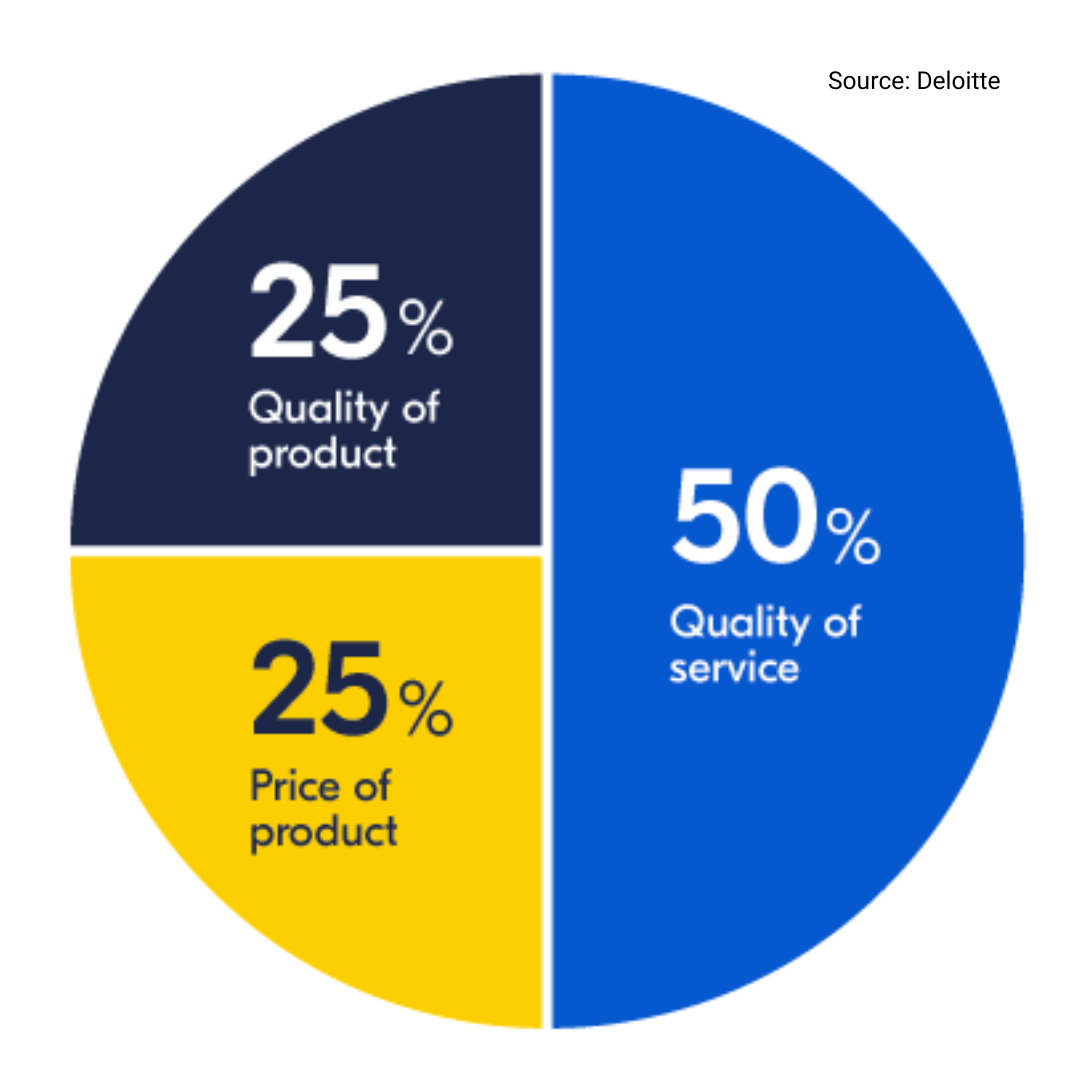
2. Long term: new revenue stream
Profit margins for services are significantly higher than those of new machine sales. In addition, after-sales service ensures a more stable revenue stream, also during economic downturns. Maintenance work is always needed, even during a recession.
The good news is that the proportion of services in the turnover of machine builders is anticipated to grow in the coming years. To achieve this growth for your own business, it’s important to address the challenges of staying connected. This demands a strategic vision, a systematic approach, and an ongoing commitment to achieving service excellence.
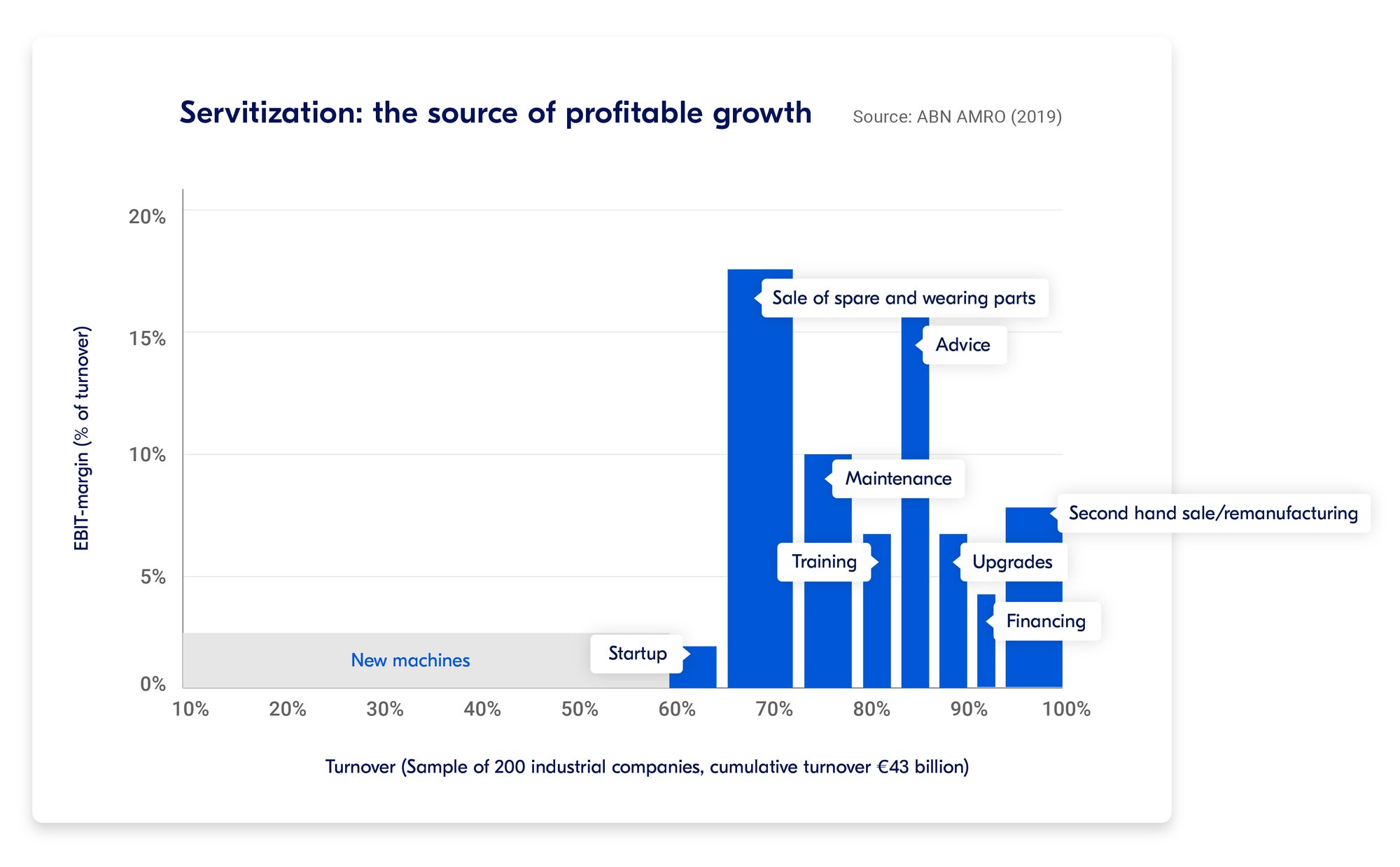
The 5 reasons why machine builders struggle with machine connectivity
While the vision of seamless machine connectivity holds immense promise, the reality for many machine builders often falls short of this ideal. A significant number of them face challenges in maintaining continuous connections to their machines in the field. This leads to missed opportunities and a widening gap in service excellence. Let's explore the five common pitfalls that contribute to this disconnect dilemma:
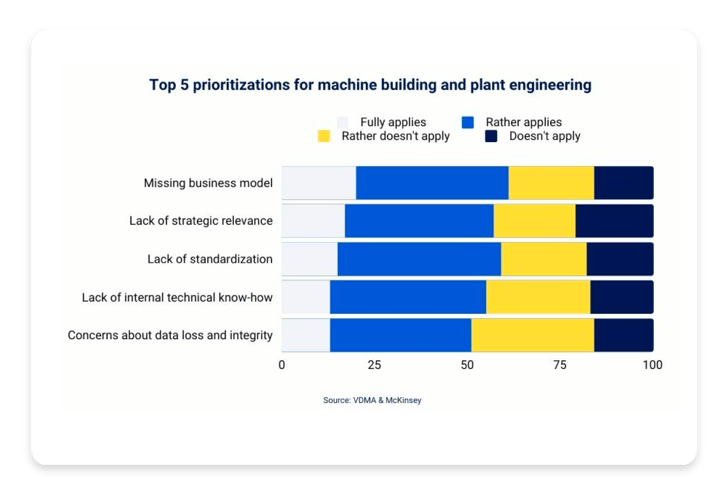
1. Missing business model
A major challenge machine builders face is explaining to their customers why accepting machine connectivity is valuable. Many customers don't immediately grasp the benefits or see how it can help them, which makes them hesitant to invest in it. This hesitation ends up slowing down wider adoption of their machine connectivity solutions.
2. Lack of strategic relevance
Some machine builders view machine connectivity as a feature rather than a strategic imperative. This short-term perspective leads to treating machine connectivity as an optional add-on. They allow customers to easily opt-out resulting in missed opportunities to deliver remote support and develop new proactive and data-driven services.
3. Lack of standardization
Due to resource constraints and legacy machines in the field, many machine builders find themselves struggling to standardize and implement a unified connectivity approach. This leads to a fragmented and inconsistent implementation of solutions, complicating the next steps towards becoming more service driven.
4. Lack of internal technical know-how
Technical expertise is crucial for successful machine connectivity. Without it, machine builders may struggle to offer dependable, secure, and creative solutions. Choosing and integrating connectivity requires a strong grasp of networking, software, hardware, and cybersecurity. Without this knowledge, you risk unreliable solutions and machines open to cyber threats.
5. Concerns about data loss and integrity
End-customers hesitate to accept connectivity due to fears of potential vulnerabilities, data breaches, and cyber attacks. Ensuring strong security measures while maintaining a seamless user experience requires a delicate balance. Compliance with key industry security standards can help convince your customer.
Immediate benefit to customers
You provide an attractive value proposition to your customers. They get a powerful tool that helps them maintain and optimize their machines with minimal hassle and downtime, because it can mostly be done remotely.
Warranty period cost recovery
For many machine builders, savings from offering remote access as standard, offset the cost of providing the edge gateway to customers free of charge during the initial warranty period.
Long-term revenue potential
Customers who experience the benefits of remote access during the warranty period are more likely to see the value in continuing the service after warranty expires. This creates potential revenue from ongoing service contracts.
We looked at the ROI of a real customer case from Albrecht Bäumer and examined three approaches: not offering remote access, offering it as a paid option, and including it as a standard feature for free. The results were really surprising.
Real-world example: reduced service costs with free remote access during warranty period
Albrecht Bäumer, a leading machine builder in the foam industry, accomplished an impressive 127% Return on Investment (ROI) by offering free remote access during their machines' warranty period. Let's take a closer look to see how they did it.
The scenario
- Albrecht Bäumer annually sells 150 machines within a 12-month warranty period.
- On average, machines experience 1 issue during the warranty phase.
- 55% of these issues can be effectively resolved through remote solutions.
- The remaining 45% require on-site intervention.
- The cost for a single on-site customer visit amounts to approx. €2.900.
Costs and savings per approach
Appr. 1: not offering remote access
Without utilizing a remote access solution, Albrecht Bäumer would be required to deploy personnel for each issue, culminating in a substantial yearly expense of €435.000. This calculation is derived from the multiplication of the number of machines (150) by the average issues per machine during the warranty period (1), and further multiplied by the cost of an on-site visit (€2.900).
Appr. 2: offering remote access as a paid option
If remote access is presented as an optional add-on, and 20% of customers choose to adopt it at a cost of €2.000, the potential savings for the company amount to €47.850. This figure is computed by multiplying the percentage of customers (20%) by the proportion of remotely solvable issues (55%) and then by the initial cost calculation (€435.000).
Appr. 3: including remote access as a standard option for free
In an alternate approach, Albrecht Bäumer's decision to integrate remote access as a standard feature for all machines during the warranty span delivered substantial gains. With 90% of machines equipped with remote access and the capacity to resolve 55% of issues remotely, the company reaped impressive savings of €215.325. This sum is achieved by multiplying the machine percentage (90%) by the issue solvability (55%) and then by the original cost calculation (€435.000).
Investment
For their remote access solution, Bäumer incorporates an IXON router in 90% of their machines, incurring an investment of €94.500 (135 routers x €700).
Calculating ROI
The formula used to calculate ROI is:
ROI = (Gain from Investment - Cost of Investment) / Cost of Investment x 100%
Applying this formula to Bäumer's case
ROI = ( (average costs of service trips * saved service trips) - investment in remote access) / investment in remote access x 100%
This yields a remarkable ROI of 127,86% for Albrecht Bäumer, indicating the significant financial benefits of offering free remote access during the warranty period.
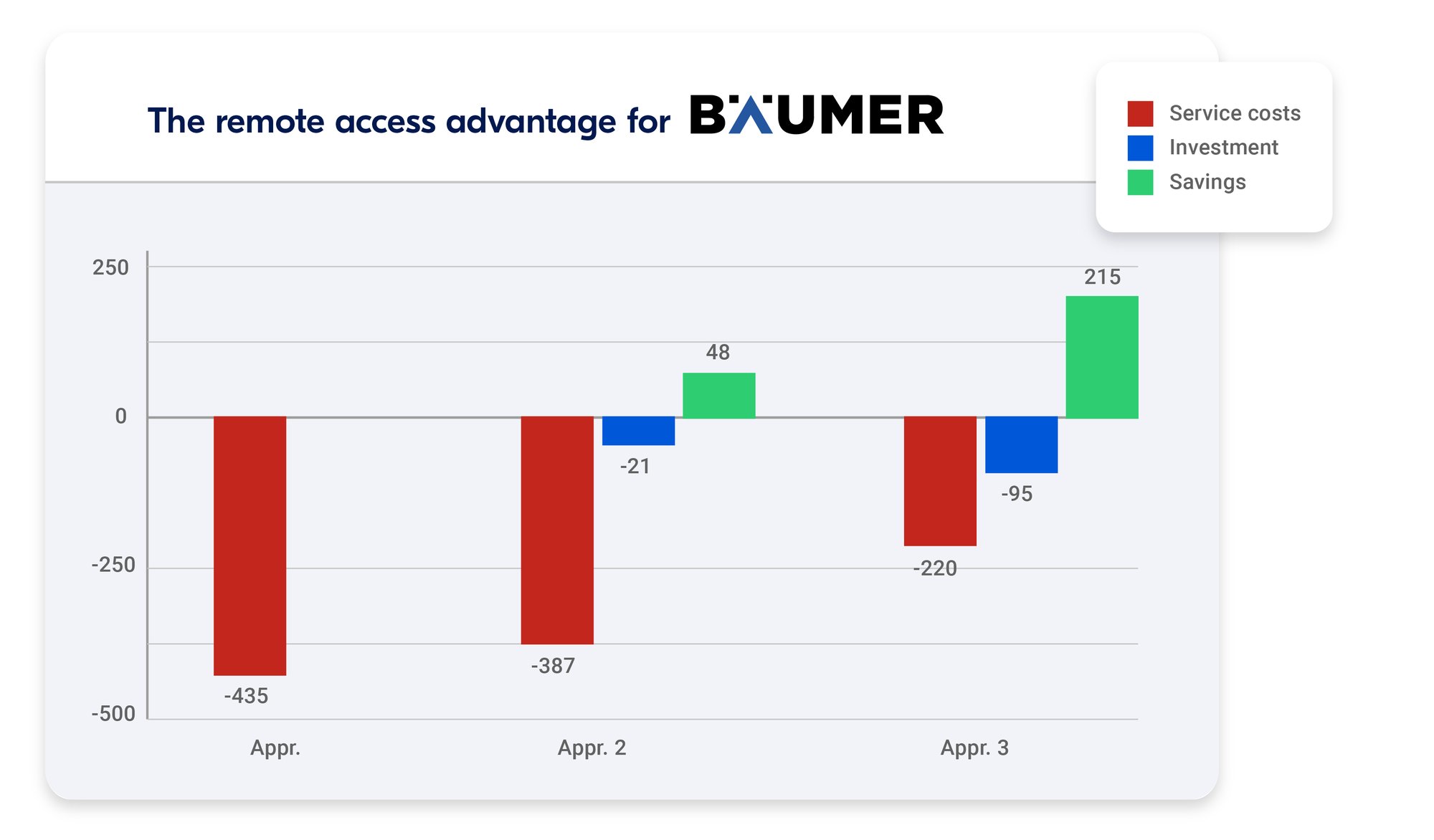
Key challenges in tracking ROI for remote access
The ROI calculation for the remote access case can be challenging to track in real life due to several factors:
1. Complexity of variables
The calculation involves a multitude of variables, such as the frequency of technical issues, the success rate of remote resolutions, customer preferences for remote access, and the associated costs. These variables can interact in intricate ways, making it difficult to isolate the impact of remote access on ROI.
If there is a mechanical problem, for example, we might use remote access to identify the problem, so that the service technician can bring the needed parts along and avoid a second visit. A case like this is not included in our calculation.
2. Availability of data
Accurate data collection and reporting are crucial for precise ROI calculations. In practice, obtaining reliable data on issues, resolutions, costs, and customer behaviors might be challenging, leading to potential inaccuracies in the ROI assessment.
For example, not every machine builder uses a ticketing system to track service cases like in this situation: the engineering team normally does not write tickets, but they use remote access very often – also for ‘on site’ development. That means not all remote access sessions during warranty are tracked with a ticket.
Considering these challenges, it's essential to approach ROI calculations for remote access solutions with a degree of flexibility and an understanding of the potential limitations in capturing the full spectrum of benefits in real-world scenarios.
Traditional remote access versus modern machine connectivity
While traditional connectivity solutions have been great for remote support, they're falling short in today's fast-changing tech landscape, where more and more machine builders are starting to develop their own IoT capabilities.
To ensure long-term success, it's time to look to the future and embrace integrated, flexible, and secure connectivity solutions. These not only enhance remote support but empower machine builders to develop new data driven services and build better customer relationships. Staying connected to your machines and customers is therefore a strategic decision, and not just an operational one based on the need for remote access from your engineering team.
Modern machine connectivity solutions have three key capabilities: smooth integrated remote access, an open and adaptable design, and unwavering focus on security and reliability. With these three elements, you'll future-proof your investment, offer efficient service, and keep your customers' trust intact.
Traditional remote access versus modern machine connectivity
| Traditional remote access | Modern machine connectivity |
|---|---|
Stand-aloneMany remote access solutions are stand-alone tools, not connected to the bigger picture of your IoT strategy and IT infrastructure. This disconnection makes it hard for data and insights to flow smoothly. As you start to build your IoT strategy, this will create operational inefficiencies and prevent you from managing your users, machines and data in one place. |
IntegratedUnify your IoT strategy with remote troubleshooting, fast customer support and improved data usage. All integrated in a single platform. Customers crave partnership, and this approach meets their high expectations for fast, effective solutions. |
Limited adaptabilityTraditional remote access solutions struggle to keep up in an ever-changing landscape. There’s demand for a machine connectivity solution that can seamlessly integrate with new tools, applications, and protocols, which allows machine builders to continually enhance their services. |
Open & expandable architectureIn the whirlwind of technological evolution, flexibility is paramount. An open architecture means no lock-in, a future-ready investment, and the ability to tailor unique solutions that cement customer relationships. |
Security concernsTraditional remote access solutions lack the strict security features required to protect sensitive machine data in today's hyper-connected sites. As cyber threats become more sophisticated, machine builders need a future-proof solution that prioritizes data privacy, confidentiality, and resilience against cyber attacks. |
Unwavering security & reliabilityConnected machines are inherently more secure, enabling remote patching and real-time safeguards for data privacy and integrity. Customer trust is invaluable, and a secure solution reinforces that trust. |
The Service R&D Framework for machine builders
Remember the disconnect dilemma and its five common pitfalls? In this section we’re going to circle back to two of those pitfalls: the lack of strategic relevance and the missing business model.
Machine builders sometimes see connectivity as just a feature, instead of something crucial. This means they offer it as an optional choice to customers who might opt out. But this short-term thinking can mean missing chances to provide support and create new services.
Another challenge is getting customers to see why machine connectivity and remote services are valuable. Some don't realize the benefits or how it can help them, so they're hesitant to pay for it. This slows down the adoption of machine connectivity.
These pitfalls don’t just apply to machine connectivity but also to other digital and data-driven services machine builders are trying to sell to their customers. That is why we are creating the Service R&D Framework: to help machine builders to systematically advance revenue-generating services from concept to fully integrated and profitable products.
The framework is designed to help machine builders identify the three phases they go through as they further develop their after-sales services. For each phase the framework will help machine builders understand what strategic decisions to make, how to operationalize each new phase, and how to measure success.

The three phases or maturity levels of the Service R&D Framework
Analyze your company’s maturity level by using this framework. It will allow you to understand where you are on your journey towards becoming a service provider and which steps to take next.
The Service R&D Framework for machine builders
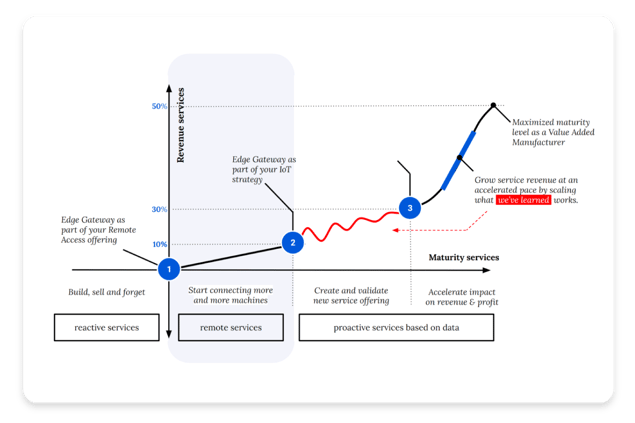
Are you interested in learning more, and following us on our journey to develop this framework further? Subscribe to our bi-weekly Connect newsletter to stay up-to-date on recent developments.
Is your current connectivity solution future-proof?
To move from remote to proactive services, staying connected has to become a strategic decision. With a connection to your machines you can detect anomalies and monitor trends remotely using real-time data instead of waiting for the customer to report issues before taking action. This move is the foundation you need to eventually shift to proactive services.
Is your current remote access solution future-proof? Does it have all the functionalities you need to move to the next phase in the Service R&D Framework?
Lay the foundation for your future services, and make machine connectivity the cornerstone of your success. With the right edge gateway, you don't just build machines; you build trust, loyalty, and a future where service excellence reigns supreme.
Our experts are ready to guide you to the best possible solution
More information on machine connectivity
What sources did we use for this content?
The following external sources were used for this content:
What is machine connectivity?
Industrial machine connectivity means that machines, equipment, and devices in industries are connected through a network. This helps in sharing data instantly, monitoring them remotely, and often using technologies like sensors and edge devices and an IIoT platform to make this happen. The result is improved efficiency, less downtime, predictive maintenance, and better productivity in industrial environments.
How to convince your customers?
Contrary to popular believe connected machines are more secure. Emphasize the importance of data security and privacy. Explain how edge gateways can help keep sensitive data on-site, reducing the risk of data breaches and ensuring compliance with regulations. Check our security guide for more info.
Offer it for free during the warranty period and explain how edge gateways enable remote monitoring and better support, which can lead to quicker issue resolution and reduced downtime. Use the warranty period to build a clear cost-benefit analysis to showcase the return on investment (ROI) of an SLA after the warranty period. Check how Baümer calculated their ROI.
Should you offer remote access for free?
We advice to offer remote access for free during the warranty period. Based on success stories from customers we believe it brings significant benefits to both the machine builder and its customers. Discover how Baümer accomplished an impressive 127% ROI.
How to choose the right edge gateway?
The machine builder of the future is a service provider. The very foundation is the physical connection with your customer’s machines. Whether it's for remote access, or for developing new services based on machine data: without this connection, nothing is possible.
Staying connected to your machines and customers is therefore a strategic decision, and not just an operational one based on the need for remote access from your engineering team. That is why IXON offers machine builders a secure, reliable and accessible way to connect their machines, team and customers on a single IoT platform.
Click here to learn more about the next generation connectivity hardware for industrial machines.
How secure is IXON?
IXON offers the most secure & reliable way to stay connected to your machines & customers. Learn more about how we have designed security into our edge devices.
Can I use TeamViewer for remote access?
Security is a crucial part of selecting the right solution, because your customers are relying on you. When you’re working as an individual or in a small business without ambitions in the field of IoT, TeamViewer can be an attractive choice.
However, when it comes to secure remote access for machine builders with multiple employees, IXON will be a more secure choice. Its industry-specific focus, robust security measures, dedicated devices, and advanced user management make it a superior choice. It's not just about remote access; it's about long-term investment and safeguarding your reputation in the digital age.
Learn more about how IXON and TeamViewer’s remote access solutions compare.